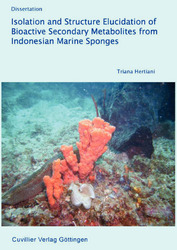| Areas | |
|---|---|
| Serie de libros (96) |
1378
|
| Nachhaltigkeit |
3
|
| Gesundheitswesen |
1
|
| Letra |
2363
|
| Ciencias Naturales |
5406
|
| Matemática | 229 |
| Informática | 319 |
| Física | 980 |
| Química | 1363 |
| Geociencias | 131 |
| Medicina humana | 243 |
| Estomatología | 10 |
| Veterinaria | 108 |
| Farmacia | 147 |
| Biología | 835 |
| Bioquímica, biología molecular, tecnología genética | 121 |
| Biofísica | 25 |
| Nutrición | 45 |
| Agricultura | 1004 |
| Silvicultura | 201 |
| Horticultura | 20 |
| Ecología y conservación de la tierra | 148 |
| Ciencias Ingeniería |
1791
|
| General |
98
|
|
Leitlinien Unfallchirurgie
5. Auflage bestellen |
|
Erweiterte Suche
Isolation and Structure Elucidation of Bioactive Secondary Metabolites from Indonesian Marine Sponges (Tienda española)
Triana Hertiani (Autor)Previo
Indice, Datei (45 KB)
Lectura de prueba, Datei (56 KB)
A total of 35 compounds comprising diverse structural groups of compounds including both alkaloids and terpenes were isolated; fourteen of which are new derivatives. The structures of the new compounds were unambiguously established on the basis of NMR spectroscopic (1H, 13C, COSY, 1H-detected direct and long range 13C-1H correlations) and mass spectrometric (EI, and ESI) data. The identities of the known compounds were established by comparison with published data.
Sponge samples originated from several collection sites in Indonesia. A combination of a chemically-and biologically driven approach for drug discovery was employed. Extracts were screened for antibacterial, antifungal, and cytotoxic activities as well as protein kinase inhibition parallel to the usage of TLC, and HPLC coupled to UV and MS in the isolation of the chemically most interesting substances.
Enumerated below are the compounds which have been isolated and structurally elucidated and whose bioactivities have been further characterized.
1. Agelas n.sp. secondary metabolites
Extract of the unidentified Agelas sponge from Peniki East Island (Seribu Islands), Jakarta, yielded sixteen structurally related brominated pyrroles, including eleven new congeners. Diverse structures of the brominated pyrroles are elucidated wherein several new functionalities are shown to be introduced in the molecule such as in agelanin A (2), agelanin B (3), and agelanesins (4 to 7). Pronounced cytotoxicity against mouse lymphoma cell (L5178Y) was shown by all agelanesins. The tyramine moiety must be responsible for the cytotoxic activity since other congeners without the tyramine unit displayed no cell-growth inhibition. Less degree of bromination on the pyrrole ring may also play a role in its cytotoxicity, considering that the monobrominated pyrrole-agelanesins, agelanesin A (4) and B (5) display lower IC50 in comparison to their dibrominated congeners, agelanesin C (6) and D (7). The iodine substituent presumably is not important for the cytotoxicity.
2. Agelas nakamurai secondary metabolites
Extract of the sponge Agelas nakamurai collected in Menjangan Island, yielded five monobrominated pyrrole derivatives, one of which is found to be a new congener, longamide C (20). A hypotaurocyamine diterpenoid, ()-agelasidine C (19) was isolated together along with adenine related compounds, adenosine and 9-methyladenine as well as the new diterpenoids derivatves, (-)-agelasine-D (18) and its congener (-)-ageloxime-D (17).
(-)-Agelasine D, (-)-ageloxime D and ()-agelasidine-C exhibit prominent cytotoxicity towards the mouse lymphoma cell line L5178Y. Biofilm inhibition assay done on (-)-agelasine D, (-)-ageloxime D, (+)-agelasidine C as well as on (-)-agelasine I suggests that the diterpene part is important for the activity together with the adeninium part. Between the (-)-agelasine D and (-)-ageloxime D, the amine unit on C-6’ is important for the antibacterial activity. A replacement of the amine unit with an oxime group as in the ageloxime D will displace the antibacterial activity but on the other hand will inhibit biofilm-formation of S. epidermidis. Both (-)-agelasine-D and (-)-ageloxime D were toxic to the cyprids larva of Balanus improvisus Darwin, where (-)-ageloxime D was approximately 10 times more toxic than (-)-agelasine D.
3. Pseudoceratina purpurea secondary metabolites
Extract of the sponge Pseudoceratina purpurea collected in Watudodol, Banyuwangi, yielded five brominated tyrosine derivatives. The presence of the antifouling substance, aplysamine-2 (27) as well as isofistularin-3-bioconversion products, (+)-aeroplysinin-1 (28), bisoxazolidinone derivatives (29), together with the dienone ketal congeners 30 and 31 were identified.
4. Axynissa sp. secondary metabolites
Search on bioactive compounds as protein kinase inhibitors has lead to the isolation of two bisabolene phenol derivatives, ()-curcuphenol (33) and ()-curcudiol (34) in the active fractions of Axynissa sp. collected from Ambon, Maluku.
5. Mycale phyllophyla secondary metabolites
Study on the sponge extract Mycale phyllophyla collected from Menjangan Island, Bali, revealed the presence of 5-pentadecyl-1H-pyrrole-2-carbaldehyde derivatives (32a) together with (E)-5-pentadec-6-enyl-1H-pyrrole-2-carbaldehyde (32b) in a cytotoxic active fraction.
6. Rhabdastrella rowi secondary metabolite
The quinolin-4-ol (35) was obtained from the Balinese marine sponge Rhabdastrella rowi extract in minute quantity. Up to now this compound has only been obtained synthetically and has never been reported from natural sources.
| ISBN-10 (Impresion) | 3867273278 |
| ISBN-13 (Impresion) | 9783867273275 |
| ISBN-13 (E-Book) | 9783736923270 |
| Formato | A5 |
| Idioma | Inglés |
| Numero de paginas | 344 |
| Edicion | 1 |
| Volumen | 0 |
| Lugar de publicacion | Göttingen |
| Lugar de la disertacion | Düsseldorf |
| Fecha de publicacion | 14.08.2007 |
| Clasificacion simple | Tesis doctoral |
| Area |
Farmacia
|
| Palabras claves | Sekundärstoffe, Indonesische marine Schwämme, pharmazuetische Biologie, pharmazuetische Chemie. |








